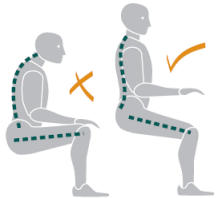Many people spend long hours working at a computer. Even with perfect ergonomics, muscle tension and pain are common complaints. It seems ironic that employers spend a lot of money on expensive office chairs, and virtually none on educating the people who use them.
Simplistic notions of “good posture” – e.g. pulling shoulders back, usually don’t work, because they don’t address the many complex aspects of good body use, and they don’t take into account people’s individual requirements.

In my practice as a Feldenkrais® practitioner, I see many clients in this situation, and help them to relieve pain by learning to sit in an upright manner, without undue muscular work.
The Feldenkrais Method was developed by Israeli physicist and engineer Dr. Moshe Feldenkrais, in response to his own knee injuries.
Dr Feldenkrais developed many specially designed movement lessons, which help to bring attention to poor habits, and replace them by more comfortable, efficient options. It utilizes the human system’s natural intelligence, and our ability to naturally self-correct when given the opportunity. Body and mind function are brought together to create new learning. Learning is distinct from exercise, in that the brain “reprograms” itself. Much like learning any new skill – riding a bike, or playing the piano – the brain remembers, and also we can continue to refine what we do.
The Method was based on Dr. Feldenkrais’s theory that new nerve pathways can be created, at any age. This theory is now backed up by modern research into brain neuroplasticity (See the popular science book “The Brain that Changes Itself” by Dr.Norman Doidge).
So, for a start, here are some ideas that might help:
• Sense the contact of your pelvis on your chair. Is the weight even on your two sit-bones?
• Shift your weight from side to side, feeling each sit-bone. Do this a few times, then check – do you feel more balanced?
• Roll your pelvis forward and back, so you alternately arch your lower back, then round it. Pause after a few times and feel if you are sitting more comfortably. Repeat, moving head up and down in time with pelvis
• Eye and neck muscles are closely related, so pause and turn your head from side to side, looking around. This will help to keep your neck free, and prevent eye strain
• Make sure your feet rest comfortably on the floor, or on a flat (not sloping) footrest
If you wish to find out more, it’s important that you find a Feldenkrais Teacher who is certified with the NZ Feldenkrais Guild (each country has it’s own professional body).
NZ Teachers are trained according to international standards. They do an initial training over a four year period, and then do continuing professional development each year.
For further information, visit www.feldenkrais.org.nz.









